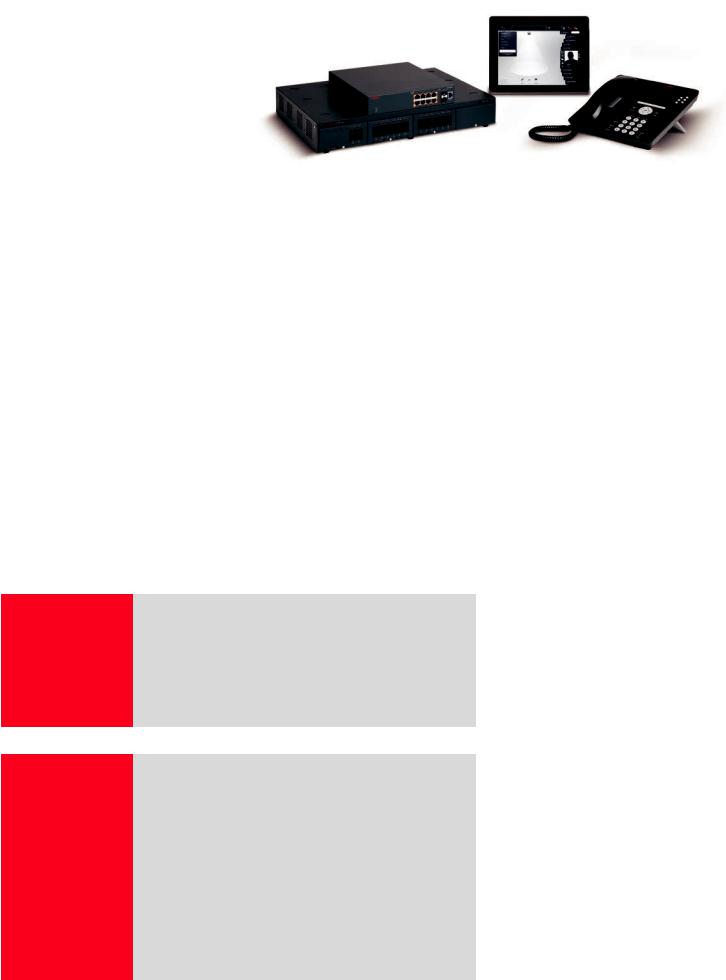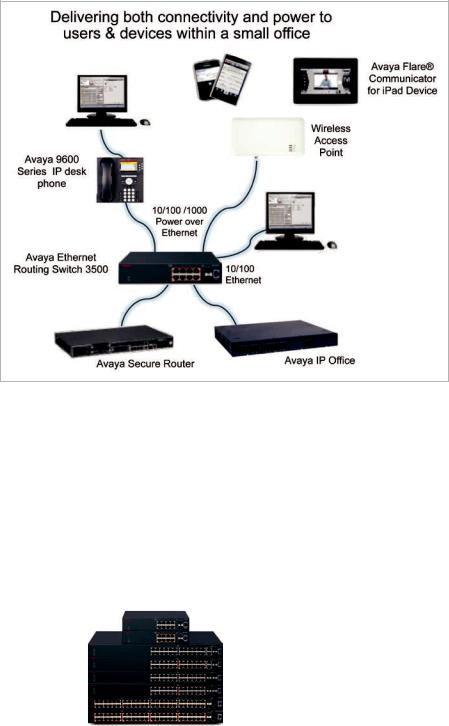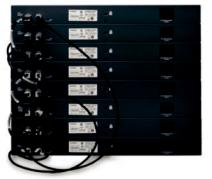Avaya ERS 3500 User Manual

AVAYA NETWORKING
AVAYA ETHERNET ROUTING
SWITCH 3500 SERIES
Figure 1: The ERS 3500 product family
HIGHLIGHTS
•Cost effective Fast Ethernet and Gigabit Ethernet switches available in 10, 24 and 48-port model variants.
•Enterprise class features at SME price points with 100+ enterprise class features at price points that fit into tight capital budgets.
•Fanless models for silent operation in open areas – ideal for classrooms,
boardrooms and retail shops.
•Resilient stacking that provides pay as you grow scaling with up to 80 Gbps of virtual backplane capacity in a stack of 8 units.
•PoE/PoE+ models for powered connection of IP Phones and other devices.
•Simplified operations including 1-minute plug- and-play capabilities for IP Phones, automatic QoS provisioning and intuitive management options.
•Unique quick set-up utility that simplifies installation with IP Office.
The Avaya Ethernet Routing Switch (ERS) 3500 is a series of eight highperformance compact Ethernet switches specifically designed for MidMarket, SMEs, branches and open environments outside the wiring closet.
A cost-effective, feature-rich solution, the ERS 3500 Series provides both standalone and stackable Ethernet switching perfectly suited to the unique requirements of Mid-Market and SME customers, as well as enterprise branch offices.
The Avaya Ethernet Routing Switch 3500 is a reliable, low-cost solution that provides converged services within single or multiple sites typically of 300 users or less.
It offers three models which can operate in fanless mode to provide silent operation for classrooms, hospitality suites, retail sites or other noise sensitive environments – outside of the wiring closet.
It also supports IEEE 802.3at PoweroverEthernet Plus (PoE+) which can power IP Phones, Wireless Access Points, surveillance cameras and other devices. PoE+ with its 32-watt power budget ensures investment protection for current as well as future highpowered end-points.
For environments that need upside capacity, all ERS 3500 24-port and 48-port models support Avaya’s Stackable Chassis architecture. This allows up to eight ERS 3500 units to be cabled together to form a single logical chassis with up to 384 user ports and 80 Gigabits of virtual backplane capacity. The ERS 3500 Stackable Chassis architecture can also improve network availability and resiliency through hotswap and link aggregation capabilities across the system.
Delivering high performance Layer 2 switching, Layer 3 local and static routing, advanced convergence and a range of security features, the ERS 3500 provides enterprise class features at an SME price. It also can automate many of today’s manual processes to simplify operations and reduce costs for the cost conscious enterprise.
avaya.com | 1

Simplified Operations |
|
|
||
The ERS 3500 is well suited for |
|
|
||
smaller environments where there |
|
|
||
might be little or no local IT staff. It is |
|
|
||
designed to be simple to install, |
|
|
||
manage and operate. And when |
|
|
||
deployed in conjunction with an |
Figure 2: ERS 3500 with IP Office, the Avaya Flare® Communicator for |
|||
|
|
|||
Avaya IP Office system the ERS 3500 |
iPad Device and an Avaya 9600 handset |
|||
|
|
|||
offers increased operational |
entire set up process on the ERS |
Validated interoperability with |
||
|
|
|||
simplicity over third party switching |
3500 switch by utilizing LLDP or |
Avaya IP Office |
||
solutions through features that both |
ADAC functionality to automatically |
Avaya has also validated |
||
|
|
|||
simplify the initial deployment as well |
|
|||
set up voice and data VLANs, QoS |
interoperability between the ERS |
|||
|
|
|||
as ongoing adds, moves and changes. |
|
|||
and policies on the IP Phones, |
3500 and the IP Office system to |
|||
|
|
|||
|
|
|
||
|
|
meaning that IP Office and IP Phones |
ensure the two products work |
|
Automated switch set up with |
|
|||
are ready to be connected |
together seamlessly. This eliminates |
|||
Avaya IP Office |
|
|||
|
|
|||
|
immediately. This helps ensure fast |
any complexities associated with |
||
|
|
|||
|
|
|
||
For deployment scenarios where |
setup and error free deployment |
having to provision, manage and |
||
|
|
|
||
there may not be a data networking |
according to Avaya best practices |
troubleshoot a third party Switch |
||
|
|
|
||
support specialist on site, the ERS |
and consistency between different |
with the Avaya voice / unified |
||
|
|
|
||
3500 provides an automated script to |
locations for large rollouts in multiple |
communications infrastructure. A |
||
enable fast, error free installation |
Branch Offices. |
Technical Solutions Guide, available |
||
when deployed with IP Office. An |
|
to partners and end customers, |
||
installation script automates the |
|
showcases best practice |
||
|
|
|
configurations, ensuring optimal |
|
The ERS 3500 Series models |
performance of the solution. |
|||
Fast Ethernet Models |
|
Certified 1-minute plug-and- |
||
|
|
|
||
ERS 3526T |
24 x 10/100Mbps + 2 Combo 10/100/1000 or SFP ports + 2 |
|||
play for IP Phones |
||||
SFP / 2.5G rear ports. Fanless. |
||||
|
||||
|
|
|
||
ERS 3526T-PWR+ |
24 x 10/100Mbps PoE+ ports + 2 Combo 10/100/1000 or SFP |
Plug-and-play means that as soon as |
||
ports + 2 SFP / 2.5G rear ports. PoE budget 370W. |
||||
|
|
|||
|
|
an IP Phone is plugged into an Avaya |
||
ERS 3550T |
48 x 10/100Mbps ports plus 2 Combo SFP ports (with ports |
|||
47-48) + 2 SFP / 2.5G rear ports. |
Ethernet Switch, the IP Phone is |
|||
|
||||
|
|
|
||
ERS 3550T-PWR+ |
48 x 10/100Mbps PoE+ ports plus 2 Combo SFP ports (with |
automatically recognized and |
||
47-48) + 2 SFP / 2.5G rear ports. PoE budget 370W. |
||||
|
|
|||
|
|
|
configured. This feature can |
|
Gigabit Ethernet Models |
|
|||
|
dramatically simplify the roll out of IP |
|||
|
|
|
||
ERS 3510GT |
8 x 10/100/1000Mbps + 2 SFP ports. Standalone and Fanless. |
Phones and simplify ongoing adds, |
||
|
|
|
||
|
8 x 10/100/1000Mbps PoE+ ports + 2 SFP ports. Standalone. |
|||
|
moves and changes; empowering |
|||
ERS 3510GT-PWR+ |
Fanless mode @ 60W PoE budget, Fan operation mode @ |
|||
|
||||
|
170W PoE budget. |
|
employees to move their own phones |
|
ERS 3524GT |
24 x 10/100/1000Mbps with 4 Combo SFP ports (with ports |
without the assistance of an outside |
||
21-24) + 2 SFP / 2.5G rear ports |
||||
|
|
|||
|
|
|
contractor. To enable this plug-and- |
|
|
24 x 10/100/1000Mbps PoE+ ports with 4 Combo SFP ports |
|||
|
|
|||
ERS 3524GT-PWR+ |
(with ports 21-24) + 2 SFP / 2.5G rear ports. PoE budget |
play capability, Avaya offers IEEE |
||
|
370W. |
|
802.1AB Link Layer Discovery |
|
|
|
|
||
ERS 3549GTS |
48 x 10/100/1000 ports, plus 2 Combo SFP ports (with ports |
|||
Protocol and LLDP-Media Endpoint |
||||
47-48), plus 1 SFP+ uplink port, plus 2 SFP / 2.5G rear ports. |
||||
|
|
|||
|
|
Discovery (LLDP-MED) as well as the |
||
|
48 x 10/100/1000 PoE+ ports, plus 2 Combo SFP ports (with |
|||
ERS 3549GTS-PWR+ |
ports 47-48), plus 1 SFP+ uplink port, plus 2 SFP / 2.5G rear |
Avaya Auto Discovery and Auto |
||
|
ports. |
|
||
|
|
|
||
|
|
|
Configuration (ADAC) feature. |
|
2 | avaya.com |
|
|
||
|
|
|
||
With LLDP enabled, the ERS 3500 learns the identification of neighboring devices and provides these details to the network management system. This enables the system to have the most up-to-date physical view of the network. In addition, ERS 3500 can dynamically apply voice VLANs and QoS to both the IP Phone and the attached Edge Switch port. When the IP Phone is moved to another location, the configuration is automatically updated. QoS is also automatically provisioned on the ERS 3500 uplink ensuring voice is given top priority into the Core. With one of the most comprehensive implementations of LLDP in the industry, Avaya offers enhancements for standards based provisioning of Avaya IP Phones via integrated and customizable TLV support.
These features not only save network operators time, they can virtually eliminate the likelihood of a provisioning error during a large IP Phone deployment. Third-party testing conducted by Miercom1 validated that when IP Phones were plugged into an Avaya Ethernet Switch, they were operational in just over 1 minute.
Intuitive Management
ERS 3500 Series offers flexible options for managing, troubleshooting and operating your devices.
•For customers more comfortable using the Command Line Interface (CLI), the ERS 3500 offers an industry-aligned CLI that is intuitive
and requires little to no formal training for individuals with networking backgrounds.
•For customers who are looking for a simple Graphical User Interface (GUI) for management and provisioning, Avaya’s Enterprise Device Manager (EDM) is an embedded web-based element management and configuration tool that enables set-up, configuration and monitoring of a single device using either HTTP or HTTPS (Secure Web). The on-box embedded version of EDM is available at no extra charge with every switch and can be accessed by a standard web browser. There is also an off-box version available as a free downloadable software plug-in that can be installed on Avaya’s Configuration and Orchestration Manager (COM) application.
•For customers rolling out many ERS 3500 devices, the Avaya Configuration and Orchestration Manager (COM) application, simplifies multi-element configuration via wizards and templates – increasing consistency and reducing the chances of error during configuration changes. COM also provides network discovery, device backup, bulk configuration management and audits of configuration changes.
•SNMP-based management (SNMP v1, v2 and v3) provides an alternative standards-based management approach as well as an interface for Configuration and Orchestration Manager.
The Avaya ERS 3500 supports secure management via IPv4 or IPv6 through features such as Secure Shell (SSHv1/2), Secure Sockets Layer (SSL), Simple Network Management Protocol (SNMPv1,2,3), IP Manager Lists, and administrative authentication via RADIUS or TACACS+ when connecting to the switch or stack.
Convergence-ready for Unified Communications, High-Definition Video and more
For businesses looking to consolidate all forms of communication – voice, video and data – on a single infrastructure, the Avaya ERS 3500 Series delivers functionality that simplifies convergence of these technologies.
Support for IEEE 802.3at PoE+ to power your Converged Device
Through support for IEEE 802.3at PoE+ which delivers up to 32 Watts of power per port to end-devices, ERS 3500s are able to power IP Phones, Wireless LAN Access Points, networked high-definition CCTV cameras and other devices. This eliminates the need for separate power supplies for each unit, enabling reduced cabling and management costs for adds, moves, or changes.
The higher power budget delivered by the PoE+ standard ensures that customers have the added flexibility of converging video surveillance traffic over the network, since pan, tilt
avaya.com | 3

and zoom cameras are one of the end devices that require the additional power provided by PoE+. It also ensures investment protection for future end points, such as new Wireless LAN Access Points (3x3 802.11n Access Points and emerging 802.11ac Access Points) as well as next-generation video phones.
The 24-port and 48-port PoE+ enabled products (ERS 3526T-PWR+, ERS 3550T-PWR+, 3524GT-PWR+ and ERS 3549GTS-PWR+) support a maximum power budget of 370 Watts. And the 10-port Gigabit Ethernet model (ERS 3510-PWR+) supports a maximum power budget of 170 Watts – dramatically higher than competitive switches in its
class – enabling it to deliver a concurrent average of 20 Watts of power to each of the eight PoE+ enabled access ports.
Comprehensive QoS capabilities
The ERS 3500 series delivers unsurpassed control for networks supporting a wide range of different application types. The ERS 3500 classifies, prioritizes and marks LAN IP traffic using up to four hardware queues on every port – including the rear SFP ports.
Classification can be based on MAC address, IP ToS/DSCP marking, IP source/destination address or subnets, TCP/UDP source/destination port/port range, IEEE 802.1p user priority bits, ingress source port, IP Protocol ID (e.g., TCP, UDP, IGMP), EtherType (e.g., IP, IPX) or the IEEE 802.1Q VLAN ID. Comprehensive
4 | avaya.com
Figure 3: ERS 3500 deployment scenario
traffic policing and traffic shaping are also supported.
Intelligent stacking solution delivering scalability, flexibility, resilience and performance
No one knows stacking like Avaya. We introduced our first Stackable Chassis
product in 1998 and have been perfecting the technology ever since. We were the first and only vendor to break the Terabit boundary with our ERS 5600 Series products and we have differentiated ourselves in the industry by ensuring that our Stackable Chassis perform like a traditional modular chassis implementation. We offer genuine
chassis-like features including true pay-as-you-grow scaling and in service maintenance and restoration. From a management perspective, our Stackable Chassis looks like a single network entity – utilizing only a single IP address.
Up to eight ERS 3500 units can be stacked – combining 24 or 48-port models – to deliver up to 80Gbps stacking throughput and up to 384 x 10/100/1000 user ports. Stacking is supported on ERS 3526T/3526TPWR+, ERS 3550T/3550T-PWR+, ERS 3524GT/3524GT-PWR+ and ERS 3549 GTS/3549 GTS-PWR+ models.
High performance architecture with true pay-as-you grow scaling
Our Stackable Chassis products combine non-blocking internal switching fabrics with high-speed virtual backplane architecture for a

high performance solution that scales proportionally as new switches are added. The ERS 3500 series scales to a maximum of 80Gbps of virtual backplane throughput by simply cabling up 8 units together. Avaya’s Stackable Chassis architecture simplifies stack management. Customers do not have to worry about different software versions on different products, since all ERS 3500 units run the same software image. The software image is loaded onto the base unit of the stack which then loads the image to all the other Switches in the stack. As new units are added to the stack, the ERS 3500 automates the software image and configuration download process. Third party testing1 has validated that new ERS 3500 units can become operational in just over 2 minutes of being cabled into the stack.
To ensure wire-speed performance, our Stackable Chassis architecture is based on a shortest-path forwarding algorithm for optimal data flow across the stack. Unlike competitive solutions that use unwieldy
logical ring or token technology, Avaya allows traffic to flow upstream and downstream simultaneously from every Switch connected to the virtual backplane, optimizing performance, resiliency, and resource utilization. Avaya has an additional advantage in that Quality-of-Service settings are honored as traffic passes over the stacking connections – providing applications with optimal performance, and a positive user experience.
All ERS 3500 24 and 48-port models come with two in-built Stackable Chassis interfaces for simple, costeffective and efficient connectivity. Unlike comparative offerings which daisy chain low-speed interfaces, this design frees uplink ports for dedicated connectivity to the backbone. In addition to the stacking cables, a return cable is also used to provide full virtual chassis resiliency and to protect against any stack port, Switch unit or cable failures.
Unlike competitive solutions which charge large premiums for stacking, the ERS 3500 offers the ability for customers to utilize its Stackable Chassis architecture without incurring any licensing or hardware costs.
In-service maintenance and restoration
Virtual hot swap, a critical serviceability and operability capability, helps ensure that failure in any stacked unit is quickly and easily rectified. Pioneered in modular switches, virtual hot swap is available in Avaya Stackable Chassis solutions where, without complex engineering, it enables immediate like-for-like unit replacement with no impact on other functionality and traffic, empowering operators to deploy our solutions just as they would a chassis. If a failure occurs, neighboring switches automatically wrap their fabric
connections to help ensure that other Switches in the stack are not impacted. The failed unit is simply disconnected from the fabric and, without pre-staging of software or configuration, a like unit is inserted, cabled, and powered-up. The Automatic Unit Replacement (AUR) process self-manages the software and configuration downloads to the new Switch then brings it online, without the need for an engineer to manage the process.
Further complementing the Avaya ERS 3500 solution, Avaya supports standards-based 802.3ad Link Aggregation as well as its own MultiLink Trunking technology that allows grouping of ports to form high-speed trunks/aggregations. These bundles or groups of ports can be distributed across different units in the same stack, delivering higher levels of resilience in case of link or switch failure to help ensure that traffic gets to its destination.
Stack health-check monitoring, a realtime, at-a-glance view of stack operational status and health,
further enhances operational and management simplicity.
Centralized Management
From a management perspective, an ERS 3500 Stackable Chassis solution appears as a single networking entity – utilizing only a single IP Address. This can significantly reduce the number of Switches to be managed within the network as a stack of up to 8 Switches can be managed just as easily as a single device.
avaya.com | 5
